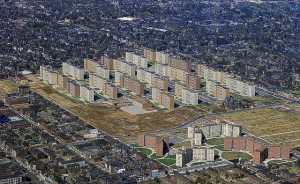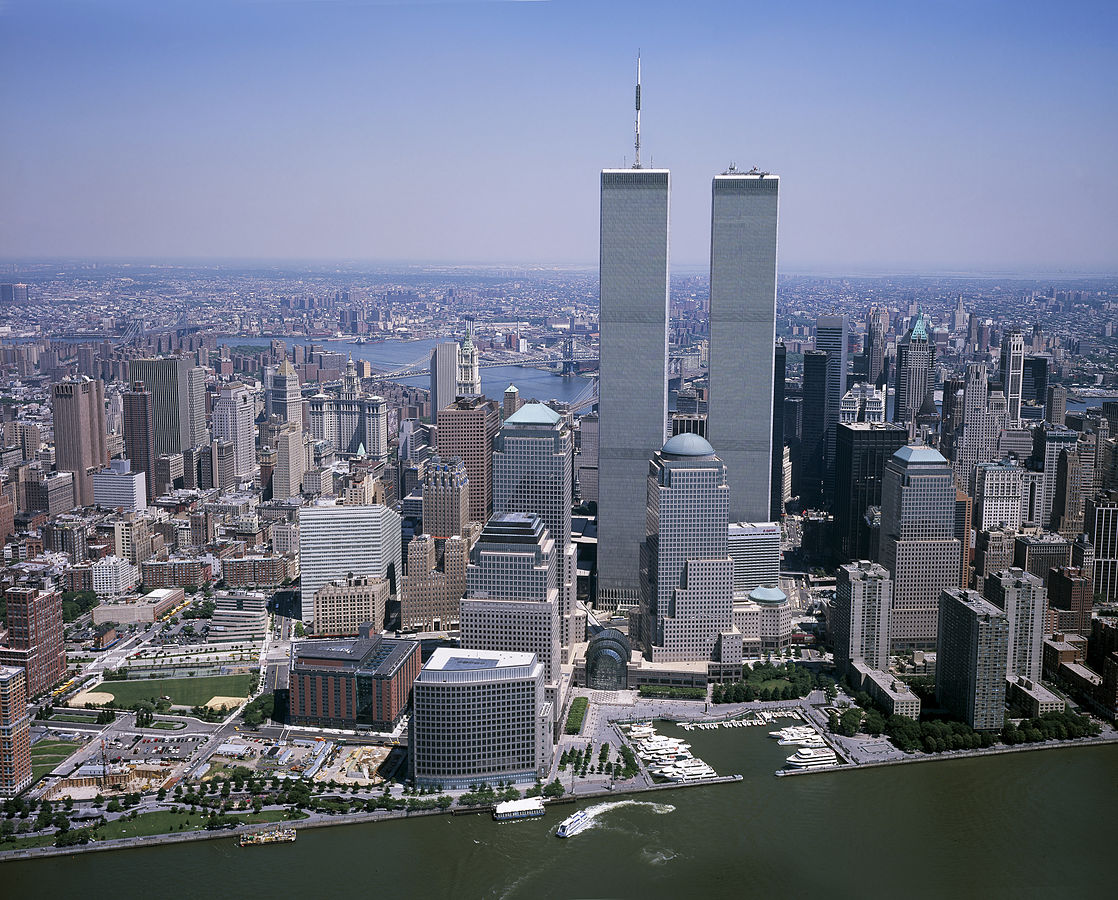Minoru Yamasaki was a twentieth-century modern architect who was best known for his designs for the Pruitt-Igoe public housing complex in Saint Louis and the World Trade Center in New York City. However, while each design was bold and triumphant in its modern style and utopian ideals, each design was profoundly problematic, and each buildings’ eventual destruction represented larger, cultural shifts away from modernism and utopianism. The destruction of Pruitt-Igoe signaled a failure of modernism to accommodate human needs, and the destruction of the World Trade Center in the terrorist attacks of September 11, 2001 marked the beginning of a new era of uncertainty for the West.
The Pruitt-Igoe housing complex and the World Trade Center were both designed with utopian ideals in consideration. Pruitt-Igoe was built and designed as a housing complex much as Le Corbusier’s Unité d’Habitation, or his Ville Contemporaine, was: the buildings are modern-style blocks rising high above the surrounding landscape, surrounded by trees, and designed to provide a full-featured, communal living experience for its residents. An aerial view of the complex, illustrating Yamasaki’s layout, is shown in Figure 1. The buildings’ elevators only stopped on floors with community centers, forcing resident interaction. In such a way, the modern architecture and modernism of the buildings forced themselves upon the residents.1 Such modern ideals of community and communalism are emblematic of the utopian hopes of the architects and governments responsible for providing public housing. The World Trade Center similarly exhibited a utopian idealism gone awry. The Twin Towers which comprise the complex “dominated the skyline” of New York City but “did not really ‘participate’ in it.”2 The towers manifested a pride and idealism representative of that in the United States and the West in the mid-twentieth century. Figure 2 is of the Twin Towers, demonstrating their relationship to the rest of the New York City skyline. They were intentionally large, utopian skyscrapers which “brought modernism to its apotheosis.”3 Such parallels of modernist and utopian idealism are fundamental to Yamasaki’s architecture in these buildings.


Eventually, both Pruitt-Igoe and the World Trade Center were destroyed, albeit in different ways. Each destruction heralded a fundamental shift in modernism and in society as a whole. Pruitt-Igoe was widely considered to be a failure of modernism; the buildings in the complex rapidly decayed as vandalism and crime ran rampant, the elevators meant to encourage community primarily inconvenienced the residents, and the units of the complex quickly lost occupancy as residents moved out. Furthermore, institutional attempts to cut costs resulted in the gutting of the primary features of the complex, such as “outdoor playgrounds, ground-floor restrooms, and finishes throughout the buildings,” which were meant to improve living conditions and community interactions.4 At the time, Yamasaki, and modernism as a whole, were blamed for the failure of Pruitt-Igoe, and when the buildings were destroyed, many considered the demolition to be the death of modernism.5 Although such proclamations were perhaps hyperbolic, they nevertheless represent a general disenchantment with modern and utopian ideals, a disenchantment with which Yamasaki was explicitly connected.
The destruction of the World Trade Center by terrorism marked the end of the twentieth century and the beginning of a new age. When the Center was designed and built by Yamasaki, the West was developing rapidly, and the buildings were meant to be built at a scale and scope to manifest the wealth and economic power of the United States. The utopianism and idealism of the West were imbued through the construction of the towers.6 The destruction of Yamasaki’s creation, however, ended this age of optimism and modern idealism. The terrorism of September 11th ended the twentieth century with finality, and ushered in a new century of uncertainty for a West that was economically, culturally, and existentially threatened by new forms of violence from the Middle and Far East. Again, just as Yamasaki’s architecture at Pruitt-Igoe represented a transition between eras, so too did his conception and later destruction of an idealistic World Trade Center mark a significant transition.
Two of Minoru Yamasaki’s designs – the Pruitt-Igoe housing complex and the World Trade Center – are significant for their modern ideals and their connections to broader social and cultural shifts. An understanding their inceptions and destructions is vital for an understanding utopian modernism and idealism.
-JH
Notes:
Figure 1: USGS, Aerial View of Pruitt-Igoe and Vaughn Housing Projects, St. Louis MO. Licensed under CC BY-ND 2.0. Available at Flickr.com, link (accessed November 24, 2015).
Figure 2: Carol M. Highsmith, Battery Park City and the Former Twin Towers at the World Trade Center. Public domain. Available at Wikimedia Commons, link (accessed November 24, 2015).
- Craig B Johnson, “Utopia and the Dirty Secret of Architecture,” Colloquy 14 (2007): 34. ↩
- Ibid., 36. ↩
- Ibid. ↩
- Sara Fernández Cendón, “Pruitt-Igoe 40 Years Later,” American Institute of Architects (2012). ↩
- Ibid. ↩
- John E. Fernandez, “A Brief History of the World Trade Center Towers” in The Towers Lost and Beyond, ed. Eduardo Kausel (Massachusetts Institute of Technology, 2002), 5-6. ↩
